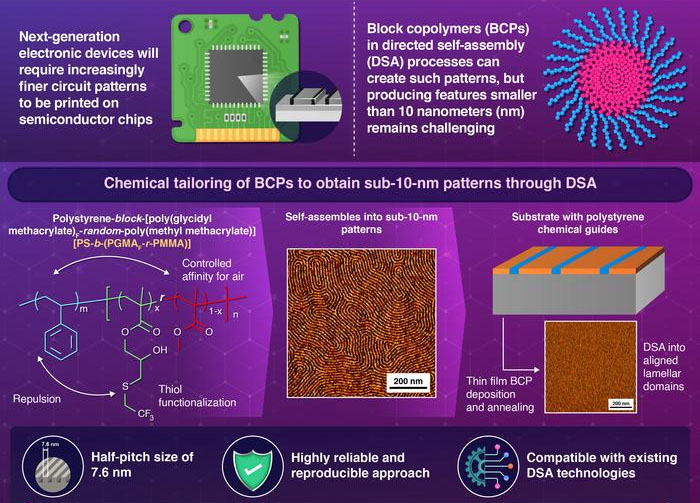| Aug 29, 2024 |
New block copolymer enables sub-10nm self-assembly, boosting semiconductor miniaturization
(Nanowerk News) Miniaturization is one of the fundamental qualities of modern electronics and is largely responsible for the incredible increments in performance witnessed over the past decades. To keep this momentum going, it is necessary to achieve circuit patterns finer than the existing ones on semiconductor chips, which are a crucial part of all electronic devices.
|
|
Some experts estimate that, by 2037, the smallest distance between features in semiconductor devices, known as ‘half-pitch,’ will need to be as small as 8 nm to support next-generation electronics, emphasizing the need for advancements in lithographic processes (method of creating highly complex circuit patterns on semiconductor parts).
|
|
As one would expect, creating such finely detailed structures on any kind of material is a massive undertaking. One promising avenue to achieve this feat is called directed self-assembly (DSA) with block copolymers (BCPs). Simply put, BCPs are long chain-like molecules made from two or more distinct sections—or blocks— of polymers. The process of DSA involves exploiting the interactions between different blocks in BCPs so that they spontaneously and consistently arrange themselves into ordered structures and patterns. While this strategy is certainly powerful, producing features smaller than 10 nanometers (sub-10 nm) using DSA remains challenging.
|
|
In a recent study published in Nature Communications ("Chemically tailored block copolymers for highly reliable sub-10-nm patterns by directed self-assembly"), researchers from Tokyo Institute of Technology (Tokyo Tech) and Tokyo Ohka Kogyo (TOK) managed to push the envelope of the possibilities in this field.
|
|
Led by Professor Teruaki Hayakawa, the research team developed a novel BCP that was carefully adapted to create incredibly small line patterns on a substrate in the form of lamellar domains (structure composed of fine and alternative layers). These tiny patterns could pave the way for new advanced semiconductor devices.
|
 |
| Chemically Tailored Block Copolymers for Generating Highly Reliable Nanometer-Scale Patterns. (Image: Tokyo Tech) (click on image to enlarge)
|
|
The newly developed BCP was created from polystyrene-block-poly(methyl methacrylate) (or PS-b-PMMA), a representative and widely studied BCP for DSA. First, the researchers introduced an appropriate amount of poly(glycidyl methacrylate) (PGMA) into PS-b-PMMA, obtaining PS-b-(PGMA-r-PMMA). Afterwards, they modified the PGMA segment with different thiols, aiming to refine the repulsive interactions between the different blocks in the resulting polymer, named PS-b-PGFM. The PS and PMMA segments also controlled the affinity of the different parts of the molecule for air, which plays an important role in its self-alignment process during DSA.
|
|
The tailored BCP reliably self-assembled into exceptionally small nanometric lamellar structures when applied as a thin film, as confirmed by atomic force microscopy. Moreover, this new compound displayed impressive performance on a substrate with parallel polystyrene chemical guides.
|
|
“Thin-film aligned lamellar domains with a vertical orientation could be reliably and reproducibly obtained via directed self-assembly, yielding parallel line patterns that correspond to a half-pitch size of 7.6 nm,” highlights Hayakawa. It is worth mentioning that this is one of the smallest half-pitch sizes reported worldwide for thin-film lamellar structures without a top coating.
|
|
Overall, these exciting findings have the potential to advance cutting-edge technologies in semiconductor manufacturing. “PS-b-PGFM BCPs are promising templates for use in lithography because they can produce fine patterns in DSA processes similar to the ones used for conventional PS-b-PMMA, with the potential to outperform them,” concludes Hayakawa. “Studies aimed at optimizing the pattern-transfer processes using line patterns in PS-b-PGFM thin films as templates will be investigated in the future,” he adds, sharing their objective for the future.
|

